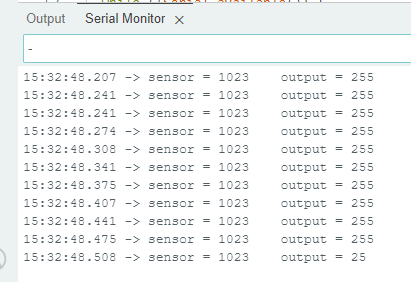Hi, I'm trying to replicate this project, the final goal is to control 4 servos with a joystick. I have a complex problem that I don't know how to troubleshoot.
I started by soldering the joystick board. At the moment I am trying to check the functionality of all components. Currently I cannot load any program onto my Arduino via USB. At the same time I receive data from one axis of one of the joysticks via Serial Port (I didn't upload any programs since I bought this Arduino board).
This situation is not affected by what program I am trying to load, nor by the fact that an external power source (9V battery) is connected/disconnected. You can see the board layout in the photo. The pin connections are following:
X, Y axis of joysticks connected A0-A3
D13 — CSN
D12 — CE
D5 — SCK
D7 — MOSI
D4 — MISO
The sketch I'm trying to download and use from this library is Optimized high speed nRF24L01+ driver class documentation: Optimized High Speed Driver for nRF24L01(+) 2.4GHz Wireless Transceiver, "Getting Started".
My final goal at this stage is to output information on all 4 axes of the joysticks, as well as information from the NRF module (I understand that I will not be able to create connections without the second module, but I want to at least get an understanding that my NRF module is soldered correctly ).
The current goal is to understand why I can't load the program onto the Arduino and how to fix it. I have another nano if needed, I haven't unpacked it yet.
I've uploaded detailed photos of my board on imgur because I can not upload more than 3 images here. The link: Imgur: The magic of the Internet
Here is what I'm getting through serial port:



I have this data (which react to movement of left joystick on up/down movement) until I'm trying to load new sketch. At this moment serial port looses connection.
The sketch I would like to use (I know that CE_PIN, CSN_PIN are different in my case, this is an example):
/*
* Copyright (C) 2011 J. Coliz <maniacbug@ymail.com>
* Updated 2020 TMRh20
*
* This program is free software; you can redistribute it and/or
* modify it under the terms of the GNU General Public License
* version 2 as published by the Free Software Foundation.
*/
/**
* Channel scanner and Continuous Carrier Wave Output
*
* Example to detect interference on the various channels available.
* This is a good diagnostic tool to check whether you're picking a
* good channel for your application.
*
* Run this sketch on two devices. On one device, start CCW output by sending a 'g'
* character over Serial. The other device scanning should detect the output of the sending
* device on the given channel. Adjust channel and output power of CCW below.
*
* Inspired by cpixip.
* See http://arduino.cc/forum/index.php/topic,54795.0.html
*/
#include "RF24.h"
#include "printf.h"
//
// Hardware configuration
//
#define CE_PIN 7
#define CSN_PIN 8
// instantiate an object for the nRF24L01 transceiver
RF24 radio(CE_PIN, CSN_PIN);
//
// Channel info
//
const uint8_t num_channels = 126;
uint8_t values[num_channels];
//
// Setup
//
void setup(void) {
//
// Print preamble
//
Serial.begin(115200);
printf_begin();
Serial.println(F("\n\rRF24/examples/scanner/"));
//
// Setup and configure rf radio
//
radio.begin();
radio.setAutoAck(false);
// Get into standby mode
radio.startListening();
radio.stopListening();
radio.printDetails();
//delay(1000);
// Print out header, high then low digit
int i = 0;
while (i < num_channels) {
Serial.print(i >> 4, HEX);
++i;
}
Serial.println();
i = 0;
while (i < num_channels) {
Serial.print(i & 0xf, HEX);
++i;
}
Serial.println();
//delay(1000);
}
//
// Loop
//
const int num_reps = 100;
bool constCarrierMode = 0;
void loop(void) {
/****************************************/
// Send g over Serial to begin CCW output
// Configure the channel and power level below
if (Serial.available()) {
char c = Serial.read();
if (c == 'g') {
constCarrierMode = 1;
radio.stopListening();
delay(2);
Serial.println("Starting Carrier Out");
radio.startConstCarrier(RF24_PA_LOW, 40);
} else if (c == 'e') {
constCarrierMode = 0;
radio.stopConstCarrier();
Serial.println("Stopping Carrier Out");
}
}
/****************************************/
if (constCarrierMode == 0) {
// Clear measurement values
memset(values, 0, sizeof(values));
// Scan all channels num_reps times
int rep_counter = num_reps;
while (rep_counter--) {
int i = num_channels;
while (i--) {
// Select this channel
radio.setChannel(i);
// Listen for a little
radio.startListening();
delayMicroseconds(128);
radio.stopListening();
// Did we get a carrier?
if (radio.testCarrier()) {
++values[i];
}
}
}
// Print out channel measurements, clamped to a single hex digit
int i = 0;
while (i < num_channels) {
if (values[i])
Serial.print(min(0xf, values[i]), HEX);
else
Serial.print(F("-"));
++i;
}
Serial.println();
} //If constCarrierMode == 0
}
I would enormously appreciate any help that you could provide. This is my first hardware/low-level software project, as I'm learning to become an embedded engineer. I am hoping for your patience. Thank you for the help.





